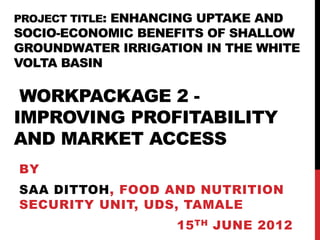
Work package 2 improving profitability and market access
- 1. PROJECT TITLE: ENHANCING UPTAKE AND SOCIO-ECONOMIC BENEFITS OF SHALLOW GROUNDWATER IRRIGATION IN THE WHITE VOLTA BASIN WORKPACKAGE 2 - IMPROVING PROFITABILITY AND MARKET ACCESS BY SAA DITTOH, FOOD AND NUTRITION SECURITY UNIT, UDS, TAMALE 15 TH JUNE 2012
- 2. INTRODUCTION (1/3) Recent research in the White Volta Basin and particularly in the Atankwidi Catchment clearly support expanded use of GW for irrigation by smallholder farmers. The expanded use is however only useful if smallholder farmers can get out of poverty through it.
- 3. INTRODUCTION (2/3) For smallholders farmers to get out of poverty two interlinked outcomes must result from their production: Production must be profitable and the profit should be substantial (farmers should attain reasonable cash security). The produce should have a sustainable market. That means if the efficiency of GW use is improved and farmers expand production but make financial losses and/or cannot sell their produce, we will be back to square one.
- 4. OBJECTIVES OF WORKPACKAGE (WP) 2 to improve the understanding of the economics of current and potential crop enterprises, (and thus recommend ways to improve profitability) and to explore interventions that help address the marketing challenges faced by shallow groundwater irrigation practitioners (to ensure sustainable profitability)
- 5. AREAS OF EMPHASIS OF WP 2 (1/2) Research-into-use activities are to be undertaken (i.e. action research) – Involves practical issues on the ground Will concentrate on practical solutions to socio- economic and institutional barriers to improving GW irrigated production by smallholder farmers. Areas of concentration will include: Costs of production – Input availability and prices including finance Participation (not involvement) of women Land use arrangements and tenure Production and price risks, including gluts and low prices Taking advantage of emerging markets Several others (to be pointed out today and later)
- 6. AREAS OF EMPHASIS OF WP 2 (2/2) WP 2 will address the following questions: Which irrigated production systems will result in higher profitability, noting very well that irrigated production is basically a commercial (business) activity? What social, cultural, economic and institutional factors hinder the achievement of higher profits in GW irrigated production? Will identify and analyse market demand, market size and competitiveness of various existing and potential irrigated products. Will assess the marketing systems’ abilities to offer sufficient incentives for shallow groundwater irrigators.
- 7. PROFITABILITY AND POTENTIAL With regards profitability and the potential for improvement, WP 2 will undertake; Rigorous analysis of the economics of crops/crop mixes as currently practiced by smallholder irrigators to identify profitable irrigated farming systems, Analyses of the profitability of potential irrigated systems, including various diversification options (to determine new remunerative opportunities for farmers). In particular the following will be considered: potential new crops (e.g., indigenous leafy vegetables) and potential other enterprises (e.g., crop-livestock and fisheries integration – “Multifunctional use of irrigated water”) Crop and other enterprises scheduling for higher profitability (e.g. Roy‟s “Three crops per year” – 300% cropping intensity)
- 8. MARKET ACCESS With respect to market access the WP 2 will: Conduct a market assessment to determine: the types of crops currently available in the market and consumer preferences for them, seasonality of availability, types of traders, (wholesaling, retailing etc.) supply and marketing chains for inputs and outputs currently produced by farmers.
- 9. EMERGING MARKETS AND IRRIGATED PRODUCT VALUE CHAINS (1/2) The increase in hotels, restaurants, fast food joints etc in the fast growing urban centres are important emerging markets that can be taken advantage of. Critical analyses and continuous review of product value chains will create markets for irrigated produce. All these will however stress on quality, constant supply of required quantity and timely supply – Those are the challenges for smallholder irrigators that this research will develop models (strategies) to address.
- 10. EMERGING MARKETS AND IRRIGATED PRODUCT VALUE CHAINS (2/2) FAO (2006) says “small scale private irrigation (in Sub-Saharan Africa) is not organized efficiently to supply markets and sustain growth”. Also “there is little value-added processing” and “spatial and value chain „friction‟” needs to be overcome (which refers to high transportation and marketing costs). WP 2 will undertake critical value-chain analyses for existing and potential irrigated commodities to recommend some value-addition at various sectors of the chains.
- 11. SIMPLE EXAMPLE OF IMPROVEMENTS OF IRRIGATED PRODUCT VALUE CHAIN • Availability and timely delivery Inputs • Low prices • Better quality Raw product • Able to deliver enough quantity • Better packaging Value added • Timely delivery
- 12. THE VALUE CHAIN SYSTEM – RELEVANT ACTORS ALONG VALUE CHAINS Input Trans- Distribution, Con- Production provision formation sales sumption Input Primary Logistic Final Con- providers producers centres, Traders sumers Industry Groups, Associations, Organisations BDS providers, NGOs, Development Partners Technical Agencies, Research, Extension Local Government, Providers of Utilities / Infrastructure National Government (Line Ministries) & Public Administration
- 13. THE MESO LEVEL Smallholder farmers have to be supported in various ways to be effective in value chains hence the importance of the meso and macro level activities in value chains. Need for effective FBOs for input (including credit) procurement, product marketing, access to research information and extension etc. (with or without NGOs and GOs). Strong FBOs ensure effective bargaining power. Capacity building of farmers and farmer organizations by NGOs, GOs and training institutions in various skills including financial and organizational management is important to instill business and management culture.
- 14. THE MACRO LEVEL World Bank (2007) says “efficient markets require good governance and public policy – infrastructure, institutions, and services that provide market information, establish grades and standards, manage risks and enforce contracts” thus the macro level is very important. There is need for strong lobbies for social and economic infrastructure to enhance production, productivity, marketing and profitability. Meso and macro level requirements will be incorporated in the models to be developed to enhance the uptake and socio-economic benefits of shallow GW irrigation in the White Volta Basin
- 15. Thank you for your attention and God bless you!